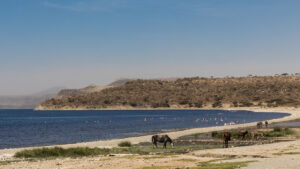
- Profile
- Tour Operators
- Accommodation
- prev
- next
- Get directions
- Bookmark
- Share
- Become an influencer
- prev
- next
Overview
Abijatta-Shalla National Park is one of the National Parks of Ethiopia.It is located in the Oromia Region and the Ethiopian Highlands region, 200 kilometers south of Addis Ababa, and east of the Ziway–Shashamane highway.It contains 887 square kilometers including the Rift Valley lakes of Abijatta and Shalla. The two lakes are separated by three kilometers of hilly land. The altitude of the park ranges from 1540 to 2075 meters, the highest peak being Mount Fike, which is situated between the two lakes.Besides the two lakes, the primary attraction of this national park are a number of hot springs on the northeast corner of Lake Abijatta, and large numbers of flamingoes on the lake. Care must be exercised in driving vehicles out to the edge of this lake, as the thin crust of dried mud on the surface can give way without warning.HistoryAlthough its intent was to protect wildlife, few wild animals currently can be viewed there. During the tumultuous period of the last days of the Derg regime, and for some time afterwards, large numbers of nomads took advantage of weakened central authority to move into the Park and set up residence with their livestock. Much of the Acacia woodland surrounding Lake Abijatta has been cut down for charcoal. Currently, not only do small groups continue to fell Acacia trees, but they go as far as to remove the salty soil from the lake shoreline and sell it.
Plan to see Abidjatta-Shalla National Park and other attractions that appeal to you using our Awasa online trip itinerary planner .
Location
-
Somali, Ethiopia
Vital Park Information
Ethiopia
887 km²
The tap water is generally NOT safe to drink anywhere in Ethiopia. Bottled water or filtered water is readily available at tourist sites, hotels, safari camps & restaurants, and hot water (boiled to make it safe) or hot tea is generally offered with a meal at a restaurant.
Ethiopian birr




